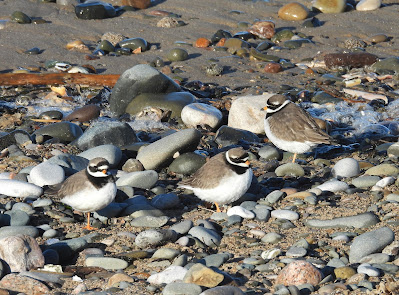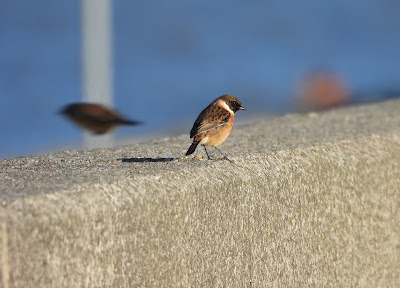January is always a busy month, and sadly it often entails spending time indoors. I have my annual tax return to file before the end of the month, then I spend lots of time getting my bird notes for the previous year up to date for the county recorder, loading records on to iRecord for plants, butterflies, moths, mammals and assorted invertebrates, all of which takes time. I am always relieved when January is out of the way. But, I did manage to get out over the past three weeks, even completing three BTO surveys.
Our first BTO survey was just over a couple of weeks ago, when Gail and I had a ringing session at our feeding station on our good friend's farm near Nateby. We had clear skies, a light south-easterly breeze, and a slight frost.
Between net rounds, sitting at the ringing table, I record everything that we see and hear, and from an observation perspective it was quiet. We logged a couple of Fieldfares and a Song Thrush, and two Buzzards, a Great Spotted Woodpecker, and 24 Lapwings went over.
We ringed 33 birds as follows (recaptures in brackets):
Tree Sparrow - 17 (1)
Great Tit - 5 (5)
Chaffinch - 4
Robin - 2 (1)
Goldfinch - 1
Dunnock - 2
Wren - 1
Blue Tit - 1 (7)
A couple of days later, we undertook BTO survey number two, our Wetland Bird Survey (WeBS) count on the reservoir adjacent to the Wyre estuary, and the old docks at Fleetwood.
It was another clear morning with a light south-easterly wind, and it was cold. In fact about 80% of the reservoir was frozen, and this is where all the birds were congregating. It doesn't usually hold any numbers of dabbling ducks, but I suspect that we had all the Shovelers from water bodies in the local area that were still frozen.
We counted 55 Shovelers, 5 Little Grebes, 21 Coots, 2 Mute Swans, 4 Moorhens, 4 Mallards, 24 Tufted Ducks, 7 Herring Gulls, and 2 Black-headed Gulls.
Ten days ago, we were in the shelter underneath the lighthouse overlooking the Wyre estuary to carry out a Winter Gull Survey (WinGS). This was BTO survey number three for the month, and this time we had full cloud cover, but that cold south-easterly wind still troubled our fingers and toes.
Our Gull roost survey totals were 51 Black-headed Gulls, 65 Common Gulls, 7 Great Black-backed Gulls, 619 Herring Gulls, and a Lesser Black-backed Gull.
Also in the estuary, were 11 Eiders, that were joined by a female Teal, and ten Shelducks. It was a very pleasant couple of hours, although we were glad to get back in the car to warm up!
Just rewinding to early afternoon, before we set off to complete our WinGS survey, we noticed that the 2nd winter male Sparrowhawk was back in our garden. Once again, he was perched in the apple tree, and he was looking at the ground where the mice feed below the feeders. At one point he looked up, and that was because a Greenfinch had landed in the apple tree above him. He's a cracking bird!
Looking at the apple tree, I noticed some fungus on one of the Willows, and after the Sparrowhawk had flown off, I went out and had a look. I identified it as Silverleaf Fungus, and my identification was confirmed by fungus guru, Fungal Punk Dave. Not rare, but we had never recorded it before, so we were very pleased.
Silverleaf Fungus
We have been keeping the feeding station going, and it requires topping up about every four days. About a week ago, I went to top up, and it was a dreich day, but I decided to have a wander through the woodland to see if I could detect any early signs of spring.
A Brambling was new in, but sadly I only heard it, but locally there has been a few around this winter. I came across three Brown Hares in the woodland, with one coming very close to me as I sheltered from the rain. I tried to get through the wet woodland, across the dyke, and in to the drier ancient semi-natural woodland, but the water was too deep. Out on the wetland were at least 150 Teal, but surprisingly no Wigeon.
I came across some Jelly Ear Fungus, and the male Hazel catkins were opening, but I couldn't find any of the delicate, red, female flowers. Perhaps it is still too early.
This morning,Gail and I had a walk to Rossall Point over the high tide to have a look at the roosting waders, and it would mainly be waders that we recorded. We found the area of the shore that the waders were roosting on, and we had 87 Turnstones, 7 Oystercatchers, 221 Sanderlings, 2 Dunlins, 7 Knots, 45 Ringed Plovers, and 2 Purple Sandpipers. We bumped into Barry, and it was nice to have a catch up with him.
The forecast isn't looking too bad over the next few days, so hopefully we'll get out some more.
Looking back in my notebook for this time last year, I had male Common Frogs calling from my garden pond, but I haven't heard any as yet! I'll have to make sure I keep popping out at night to have a listen. I suspect that it is too cold at the moment.


























